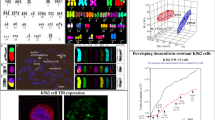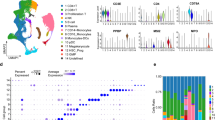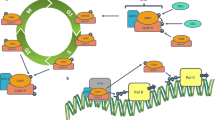Abstract
Core histones are proteins organized in octamers, to which DNA is wrapped more or less tightly, depending on their acetylation status. Gene transcription is regulated by a complex series of epigenetic modifications, i.e., histone modification such as methylation and acetylation, events determined by the enzymatic activity of histone methyltransferases, and histone acetyltransferases, respectively, the latter counterbalanced by histone deacetylases (HDAC). Acetylation of histones facilitates destabilization of DNA–nucleosome interaction and renders DNA more accessible to transcription factors. Methylation of different specific lysine residues of histones is differently linked to euchromatin (transcripted DNA) or heterochromatin (silenced DNA). On the other hand, methylation of the promoter regions of some genes by DNA methyltransferases (DNMT) leads to transcriptional silencing and is a common mechanism to regulate gene expression. In normal eukaryotic cells, DNA methylation and histone acetylation are interdependent and maintain equilibrium, allowing temporal expression of genes. In neoplastic cells, this balance is frequently disrupted. In leukemic cells, hypermethylation of CpG islands in the promoter region of genes critical for cell cycle and maturation is frequent, and DNMTs were found to be overexpressed, findings paralleled by evidence of transcriptional repression of downstream genes. Therefore, the combination of HDAC and DNMT inhibitors has been considered to be a possible therapeutic approach to restore normal gene expression in acute myeloid leukemia (AML) and other diseases. Human AML1/ETO Kasumi cells were exposed to the HDAC inhibitor D1 (O-n-butanoil-2,3-O-isopropylidene-alpha-d-mannofuranoside) and 5-aza-deoxycytidine (decitabine) alone and in combination. Histone acetylation as measured by flow cytometry was increased following treatment with D1 and the combination of D1 and decitabine. Addition of D1 alone or in combination with decitabine also led to inhibition of cell proliferation and induction of apoptosis. Thus, treatment of AML with HDAC inhibitors such as D1 and DNMT inhibitors such as decitabine might have clinical benefit for patients, especially these presenting subtypes of AML, like AML1/ETO, in which the leukemogenic mechanism involves corepressor protein complexes containing HDAC and DNMT.





Similar content being viewed by others
References
Alcalay M, Orleth A, Sebastiani C, Meani N, Chiaradonna F, Casciari C, Sciupi MT, Gelmetti V, Riganelli D, Minacci S, Fagioli M, Pelicci PG (2001) Common themes in the pathogenesis of acute myeloid leukemia. Oncogene 10:5680–5694
Asou H, Tashiro S, Hamamoto K, Osuji A, Kita K, Kamada N (1991) Establishment of a human acute myeloid leukemia cell line (Kasumi-1) with 8;21 chromosome translocation. Blood 77:2031–2036
Bergmann L, Maurer U, Weidmann E (1997) Wilm's tumor gene expression in acute myeloid leukemias. Leuk Lymphoma 25:435–443
Cheung P, Lau P (2005) Epigenetic regulation by histone methylation and histone variants. Mol Endocrinol 19:563–573
Cilloni D, Saglio G (2004) WT1 as a universal marker for minimal residual disease detection and quantification in myeloid leukemias and in myelodysplastic syndrome. Acta Haematol 112:79–84
Davie JR (1997) Nuclear matrix, dynamic histone acetylation and transcriptionally active chromatin. Mol Biol Rep 24:197–207
Di Croce L, Raker VA, Corsaro M, Fazi F, Fanelli M, Faretta M, Fuks F, Lo Coco F, Kouzarides T, Nervi C, Minucci S, Pelicci PG (2002) Methyltransferase recruitment and DNA hypermethylation of target promoters by an oncogenic transcription factor. Science 295:1079–1082
Downing JR (1999) The AML1-ETO chimaeric transcription factor in acute myeloid leukaemia: biology and clinical significance. Br J Haematol 106:296–308
Drummond CD, Noble CO, Kirpotin DB, Guo Z, Scott GK, Benz CC (2005) Clinical development of histone deacetylase inhibitors as anticancer agents. Annu Rev Pharmacol Toxicol 45:495–528
Eden S, Hashimshony T, Keshet I, Cedar H, Thorne AW (1998) DNA methylation models histone acetylation. Nature 394:842
Fazi F, Travaglini L, Carotti D, Palitti F, Diverio D, Alcalay M, McNamara S, Miller WH, Coco FL, Pelicci PG, Nervi C (2005) Retinoic acid targets DNA-methyltransferases and histone deacetylases during APL blast differentiation in vitro and in vivo. Oncogene 24:1820–1830
Felsenfeld G, Groudine M (2003) Controlling the double helix. Nature 42:448–453
Fliegauf M, Stock M, Berg T, Lubbert M (2004) Williams-Beuren syndrome critical region-5/non-T-cell activation linker: a novel target gene of AML1/ETO. Oncogene 23:9070–9081
Gelmetti V, Zhang J, Fanelli M, Minacci S, Pelicci PG, Lazar MA (1998) Aberrant recruitment of the nuclear receptor corepressor-histone deacetylase complex by the acute myeloid leukemia fusion partner ETO. Mol Cell Biol 18:7185–7191
Gilbert J, Gore SD, Herman JG, Carducci MA (2004) The clinical application of targeting cancer through histone acetylation and hypomethylation. Clin Cancer Res 10:4589–4596
Gore SD, Weng LJ, Zhai S, Figg WD, Donehower RC, Dover GJ, Grever M, Griffin CA, Grochow LB, Rowinsky EK, Zabalena Y, Hawkins AL, Burks K, Miller CB (2001) Impact of the putative differentiating agent sodium phenylbutyrate on myelodysplastic syndromes and acute myeloid leukemia. Clin Cancer Res 7:2330–2339
Gozzini A, Rovida E, Dello Sbarba P, Galimberti S, Santini V (2003) Butyrates, as a single drug, induce histone acetylation and granulocytic maturation: possible selectivity on core binding factor-acute myeloid leukemia blasts. Cancer Res 24:8955–8961
Herman JG, Baylin SB (2003) Gene silencing in cancer in association with promoter hypermethylation. N Engl J Med 349:2042–2054
Jones PA, Taylor SM (1990) Cellular differentiation, cytidine analogs and DNA methylation. Cell 20:85–93
Klisovic MI, Maghraby EA, Parthun MR, Guimond M, Sklenar AR, Whitman SP, Chan KK, Murphy T, Anon J, Archer KJ, Rush LJ, Plass C, Grever MR, Byrd JC, Marcucci G (2003) Depsipeptide (FR 901228) promotes histone acetylation, gene transcription, apoptosis and its activity is enhanced by DNA methyltransferase inhibitors in AML1/ETO-positive leukemic cells. Leukemia 17:350–358
Kuendgen A, Strupp C, Aivado M, Bernhardt A, Hildebrandt B, Haas R, Germing U, Gattermann N (2004) Treatment of myelodysplastic syndromes with valproic acid alone or in combination with all-trans retinoic acid. Blood 104:1266–1269
Leone G, Voso MT, Teofili L, Lubbert M (2003) Inhibitors of DNA methylation in the treatment of hematological malignancies and MDS. Clin Immunol 109:89–102
Liu S, Shen T, Huynh L, Klisovic MI, Rush LJ, Ford JL, Yu J, Becknell B, Li Y, Liu C, Vukosavljevic T, Whitman SP, Chang KS, Byrd JC, Perrotti D, Plass C, Marcucci G (2005) Interplay of RUNX1/MTG8 and DNA methyltransferase 1 in acute myeloid leukemia. Cancer Res 65:1277–1284
Livak KJ, Schmittgen TD (2001) Analysis of relative gene expression data using real-time quantitative PCR and the 2(-Delta Delta C(T)) method. Methods 25:402–408
Marks P, Rifkind RA, Richon VM, Breslow R, Miller T, Kelly WK (2001) Histone deacetylases and cancer: causes and therapies. Nature Rev Cancer 1:194–202
Minucci S, Nervi C, Lo Coco F, Pelicci PG (2001) Histone deacetylases: a common molecular target for differentiation treatment of acute myeloid leukemias? Oncogene 20:3110–3115
Ogryzko VV, Schiltz RL, Russanova V, Howard BH, Nakatani Y (1996) The transcriptional coactivators p300 and CBP are histone acetyltransferases. Cell 87:953–959
Partha M, Singal R (2004) DNA methylation and cancer. J Clin Oncol 22: 4632–4642
Piekarz R, Bates S (2004) A review of depsipeptide and other histone deacetylase inhibitors in clinical trials. Curr Pharm Des 10:2289–2298
Pouillart P, Douillet O, Scappini B, Gozzini A, Santini V, Grossi A, Pagliai G, Strippoli P, Rigacci L, Ronco G, Villa P (1999) Regioselective synthesis and biological profiling of butyric and phenylalkylcarboxylic esters derivated from d-mannose and xylitol: influence of alkyl chain length on acute toxicity. Eur J Pharm Sci 7:93–106
Richon VM, Emiliani S, Verdin E, Webb Y, Breslow R, Rifkind RA, Marks PA (1998) A class of hybrid polar inducers of transformed cell differentiation inhibits histone deacetylases. Proc Natl Acad Sci U S A 95:3003–3007
Saito A, Yamashita T, Mariko Y, Nosaka Y, Tsuchiya K, Ando T, Suzuki T, Tsuruo T, Nakanishi O (1999) A synthetic inhibitor of histone deacetylase, MS-27-275, with marked in vivo antitumor activity against human tumors. Proc Natl Acad Sci U S A 96:4592–4597
Santini V, Scappini B, Gozzini A, Grossi A, Villa P, Ronco G, Douillet O, Pouillart P, Bernabei PA, Rossi Ferrini P (1998) Butyrate-stable monosaccharide derivatives induce maturation and apoptosis in human acute myeloid leukaemia cell. Br J Haematol 101:529–538
Santini V, Kantarjian HM, Issa JP (2001) Changes in DNA methylation in neoplasia: pathophysiology and therapeutic implications. Ann Intern Med 134:573–86
Schmelz K, Sattler N, Wagner M, Lubbert M, Dorken B, Tamm I (2005) Induction of gene expression by 5-aza-2′-deoxycytidine in acute myeloid leukemia (AML) and myelodysplastic syndrome (MDS) but not epithelial cells by DNA-methylation-dependent and -independent mechanisms. Leukemia 19:103–111
Shaker S, Bernstein M, Momparler LF, Momparler RL (2003) Preclinical evaluation of antineoplastic activity of inhibitors of DNA methylation (5-aza-2′-deoxycytidine) and histone deacetylation (trichostatin A, depsipeptide) in combination against myeloid leukemic cells. Leuk Res 27:437–444
Wade PA, Jones PL, Vermaak D, Veenstra GJC, Imhof A, Sera T, Tse C, Ge H, Shi Y-B, Hansen JC, Wolffe AP (1998) Histone deacetylase directs the dominant silencing of transcription in chromatin: association with MeCP2 and the Mi-2 chromodomain SWI/SNF ATPase. Cold Spring Harbor Symposia on Quantitative Biology, Symposium 63:435–446
Wang J, Hoshino T, Redner RL, Kajigaya S, Liu JM (1998) Protein ETO, fusion partner in t(8;21) acute myeloid leukemia, represses transcription by interaction with the human N-CoR/mSin3/HDAC1complex. Proc Natl Acad Sci U S A 95:10860–10865
Acknowledgements
We thank Dr. Ferrari for preparing the figures and Dr. V. Barbetti for performing the Western blots.
This work was supported by Ente Cassa di Risparmio di Firenze e Ministero per la Istruzione, l'Università e la Ricerca (MIUR).
Author information
Authors and Affiliations
Corresponding author
Rights and permissions
About this article
Cite this article
Gozzini, A., Santini, V. Butyrates and decitabine cooperate to induce histone acetylation and granulocytic maturation of t(8;21) acute myeloid leukemia blasts. Ann Hematol 84 (Suppl 1), 54–60 (2005). https://doi.org/10.1007/s00277-005-0006-z
Published:
Issue Date:
DOI: https://doi.org/10.1007/s00277-005-0006-z




